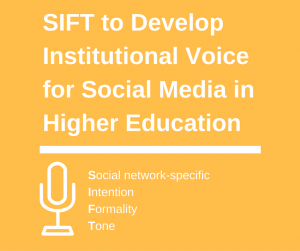
In March I had the opportunity to present a social media strategy workshop at the CASE Social Media and Community conference. During the break, I got the same question from multiple people:
“How do I convince our University Communications department not to sound like a press release on social media?”
Why is Institutional Voice Important for Social Media?
Social media is an environment that is still foreign to many experienced campus communicators.
Just like you’d spend some time figuring out the phrases and customs of a new country before you visit, or learn the fan chants before attending a large sporting event, or brush up on dining etiquette before visiting a fancy restaurant, it’s important to understand the conversation customs of social media and how your institution can fit in.
The language you’d use to pitch a reporter is very different from how you’d explain the same concept to a family at new student orientation — and neither may be an exact fit for social media.
Developing Institutional Voice for Social Media in Higher Education
 To find your voice and develop guidelines, you need to engage in the S.I.F.T. (Social Network-Specific, Intention, Formality, Tone) process I’m describing below.
To find your voice and develop guidelines, you need to engage in the S.I.F.T. (Social Network-Specific, Intention, Formality, Tone) process I’m describing below.
Social Network-Specific
What works on Facebook doesn’t always work on Twitter, and may seem utterly out of place on Snapchat. Character constraints, use of text, images, or video, and the way messages are broadcast all vary from network to network. Make sure you understand the ins and outs of each network where you maintain a social profile, and adapt your messages to each platform.
Intention
If you haven’t already, develop clear guidance regarding the purpose of your campus or department social media presence.
Possible intentions include information, help, encouragement, and empowerment. Having a discussion with stakeholders about the intentions of your social media presence will serve as a key guidepost when you’re faced with a choice of whether to engage or not engage (e.g., whether you should engage with an irate student, a member of the press, or fans of athletics programs).
Formality
Social media communication is often more informal than written communication, but each campus will feel comfortable with different degrees of formality. Consider if you are comfortable with the following informal aspects of online communication.
- Internet abbreviations such as LOL, F2F
- Emoji
- Common slang
- Memes
- Trending topics
- Animated gifs
There is not a wrong answer to these questions, but they should be considered prior to determining your institutional voice. In my program, for example, I expect language to be a bit more formal on Facebook than Twitter (because we have the room), but I also encourage the use of a well-positioned gif or meme in response to a comment (as long as we don’t violate copyright).
Tone
Tone is the degree of seriousness with which a social account approaches online communication. Establishing guidelines for the tone of your social media voice will help you develop a consistent persona and provide standards for account managers to follow when engaging in live online conversations.
The following questions help define a brand’s desired tone.
- Will you make fun of yourself?
- Will you joke with your community?
- Will you use sarcasm?
- Do you portray yourself only as an authoritative source of information?
Develop Social Institutional Voice Guidelines
Once you’ve completed the S.I.F.T. discussions, take some time to record the outcome on paper — write social institutional voice guidelines.
Not only will this serve to document the outcome of your discussions, but it will provide consistency as new staff join the office. It can also be an excellent resource to describe your social media strategy (in part) to new leadership.
Two Examples of Campus Social Institutional Voice
 The first thing mentioned in Ohio State’s social media strategy is how to share stories within the institutional voice.
The first thing mentioned in Ohio State’s social media strategy is how to share stories within the institutional voice.
“Ohio State is an institution, but should not feel “institutional” on social media; we are friendly, conversational and down to earth, just like Ohio State itself.”
 During Social Media Breakfast Madison in March 2012, the University of Wisconsin-Madison described its social institutional voice in two words: “inspired goofiness.”
During Social Media Breakfast Madison in March 2012, the University of Wisconsin-Madison described its social institutional voice in two words: “inspired goofiness.”
The @UWMadison voice: inspired goofiness. Love it. Social media is social. Don't talk like an admin/press release. #smbmad
— Dr. Liz Gross (@lizgross144) March 21, 2012
Has your campus developed institutional voice guidelines for social media? If they’re published, please share a link in the comments!
Meet the Author: Dr. Liz Gross
Dr. Liz Gross is a graduate of the Higher Ed Experts Web Analytics certificate program. Higher Ed Experts is a professional online school for digital professionals working in universities and colleges.
When you take a professional certificate course with us, you get a chance to upgrade your skills by working on your projects, interacting with classmates just like you and getting detailed personalized feedback from your instructor.
Dr. Liz Gross is now the director of Campus Sonar, a social media listening consultancy.
Liz received her Ph.D. in Leadership for the Advancement of Learning and Service in Higher Education from Cardinal Stritch University. Her dissertation research examined the relationship between communication methods and the frequency and content of college student interactions with faculty.
She also taught for 2 years and half Higher Ed Expert’s 4-week online course on Social Media Measurement for Higher Education.
Tags: Higher Ed Marketing Memos, Higher Ed News
Great minds think alike! I presented on how to ‘S.I.F.T.’ through your content for Accessibility back on February 23rd at OmniUpdate’s User Training Conference: (https://outc16.com/schedule/), and am presenting on this topic again at HighEdWeb later this month! (https://2016reg.highedweb.org/psessions/detail/9a0d972d-04e4-46e6-85f8-cf6b04b2598a). Really enjoyed your article!
Ah, I guess it’s an acronym that’s good for multiple higher ed uses! Good luck on your HighEdWeb presentation!